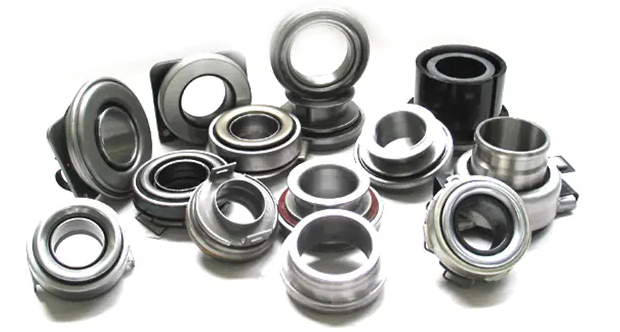Basic Concept of Clutch Release Bearing
The clutch release bearing is an important component of the automobile clutch system. It is mainly responsible for transmitting the force when the driver steps on the clutch pedal, thereby achieving the separation of the clutch. It serves as the contact medium between the clutch pressure plate and the release lever to ensure the smooth operation of the clutch during the engagement and separation process. The design of the clutch release bearing has a direct impact on the performance and life of the clutch system.
Main Function of Clutch Release Bearing
The main function of the clutch release bearing is to achieve smooth separation and engagement of the clutch. When the driver steps on the clutch pedal, the release bearing presses against the release finger ring of the clutch pressure plate to cause the pressure plate to separate from the flywheel, cut off the engine power transmission, and achieve the speed change operation. The bearing needs to withstand large axial loads and high-speed rotation while maintaining a low friction state to reduce wear and noise.
Working Principle of Clutch Release Bearing
The clutch release bearing is installed at the front end of the gearbox input shaft and is connected to the clutch pedal through a release rod or a release fork. When the clutch pedal is pressed, the release rod pushes the release bearing to move axially, and the rolling elements in the bearing are subjected to the pressure of the release finger ring under high-speed rotation. The bearing transmits force to the pressure plate, realizes the separation of the pressure plate and the flywheel, and cuts off the power transmission. When the pedal is released, the release bearing returns to its original position and the clutch reengages.

Structural features of clutch release bearing
The clutch release bearing is usually composed of a bearing body, inner and outer rings, rolling elements, seals and lubricants. The bearing body must have a certain strength and wear resistance, the rolling elements are steel balls or rollers, and the seals prevent lubricant leakage and impurities from entering. The overall structure is compact, ensuring efficient operation in a limited space. The bearing design takes into account both load-bearing capacity and friction performance to reduce energy loss.
Lubrication method of clutch release bearing
The clutch release bearing mostly adopts a sealed lubrication structure with pre-installed grease inside to ensure the lubrication of the rolling elements and raceways and extend the service life of the bearing. The sealing design avoids lubricant leakage and external contamination to ensure stable operation of the bearing under different working conditions. Some high-performance bearings also use special grease to adapt to high temperature environments.
Service life and maintenance of clutch release bearing
The service life of the clutch release bearing is affected by the use environment, installation process and maintenance. Correct installation and use can extend the life of the bearing and avoid failures caused by overload, insufficient lubrication or foreign matter intrusion. Some vehicles are equipped with durable bearings to reduce maintenance frequency. During maintenance, check whether the bearing rotates smoothly, whether there is abnormal noise and wear, and replace damaged parts in time.
Common faults and judgments of clutch release bearings
Common faults include bearing noise, stagnation and premature wear. If you find abnormal noise or unsmooth separation during clutch operation while driving, it may be a problem with the release bearing. By checking the rotation state and surface wear of the bearing, you can judge whether it needs to be replaced. Regular maintenance and timely replacement are important measures to ensure the stable operation of the clutch system.
Recommendations for purchasing clutch release bearings
When purchasing clutch release bearings, you should consider the vehicle model, use environment and bearing material. High-quality materials and reasonable design help improve load-bearing capacity and durability. Some manufacturers provide special bearings for different models, and users should choose products with good matching. At the same time, paying attention to the lubrication performance and sealing structure of the bearing will help improve the overall use effect.
The difference between clutch release bearings and traditional bearings
The clutch release bearing is designed for the special working conditions of the clutch system and has the ability to withstand axial loads and high-speed rotation. Compared with ordinary ball bearings, it has better sealing, more compact structure, and stronger high temperature resistance. In addition, the release bearing is subjected to greater impact force when the clutch is actuated, so it has higher requirements for materials and processes.
Comparison table of performance parameters of clutch release bearings
| Parameter | Description | Typical Range/Characteristics |
|---|---|---|
| Axial Load | Axial force the bearing can bear | From hundreds to thousands of Newtons |
| Speed Range | Rotational speed the bearing can handle | Approximately 1000 to tens of thousands rpm |
| Material | Main material of the bearing | High carbon steel, stainless steel, or alloy steel |
| Lubrication Method | Built-in lubrication or external lubrication | Sealed grease |
| Operating Temperature Range | Temperature range the bearing can operate in | About -40℃ to 150℃ |
| Estimated Lifetime | Usage duration under normal conditions | From tens of thousands to hundreds of thousands of kilometers, depending on conditions |
| Sealing Structure | Dust and water protection design | Various sealing solutions to prevent contamination and lubricant leakage |
Copyright © Ningbo Demy (D&M) Bearings Co., Ltd. All Rights Reserved.

